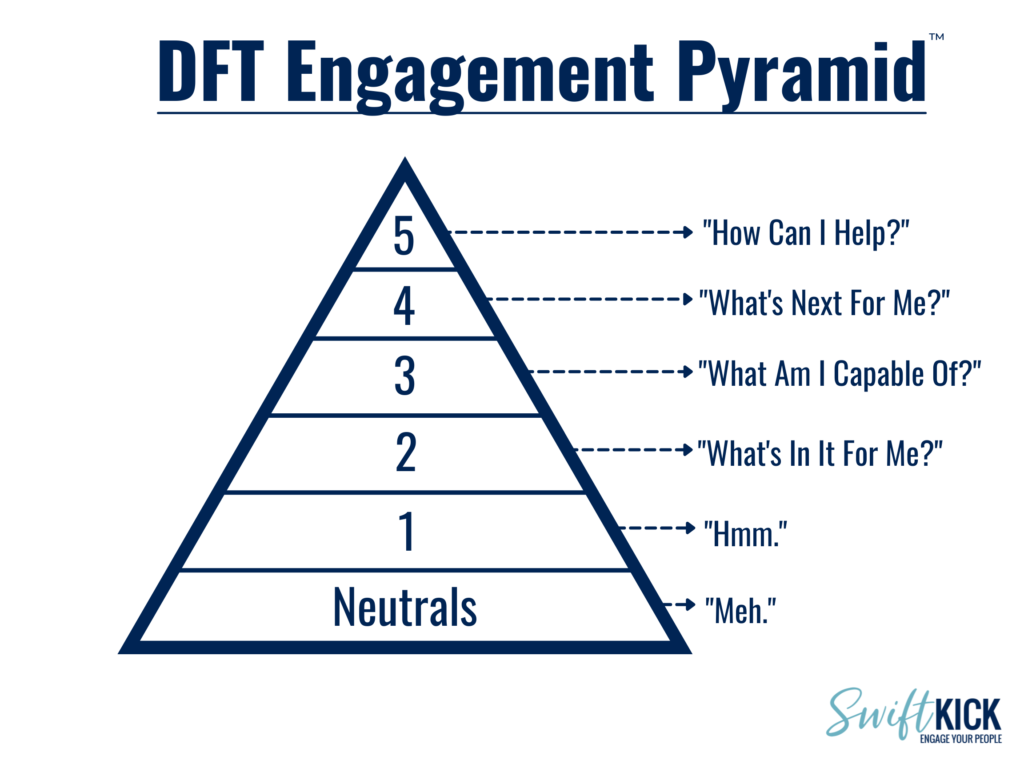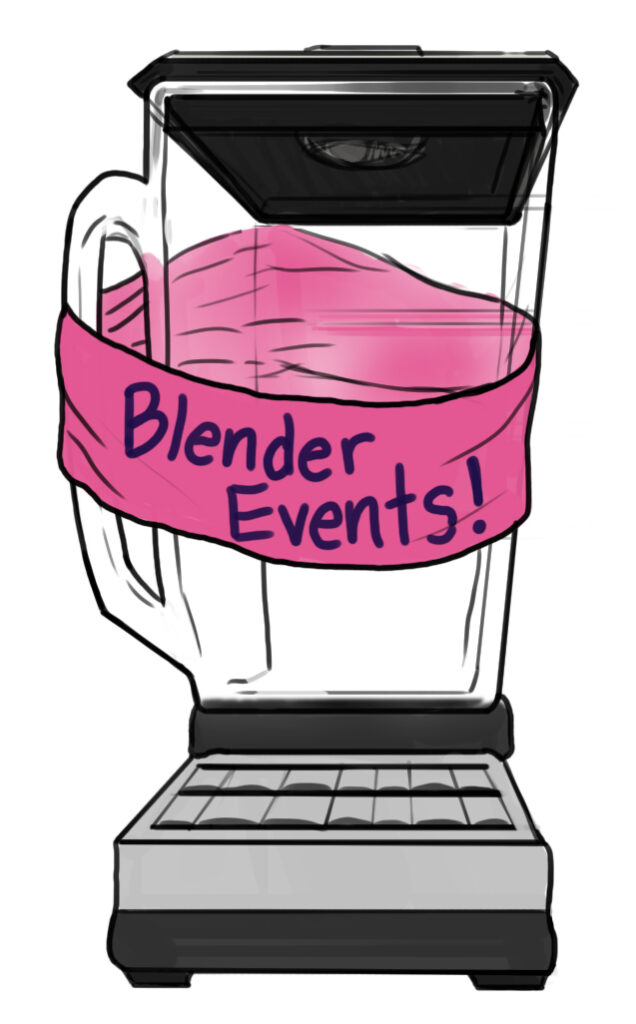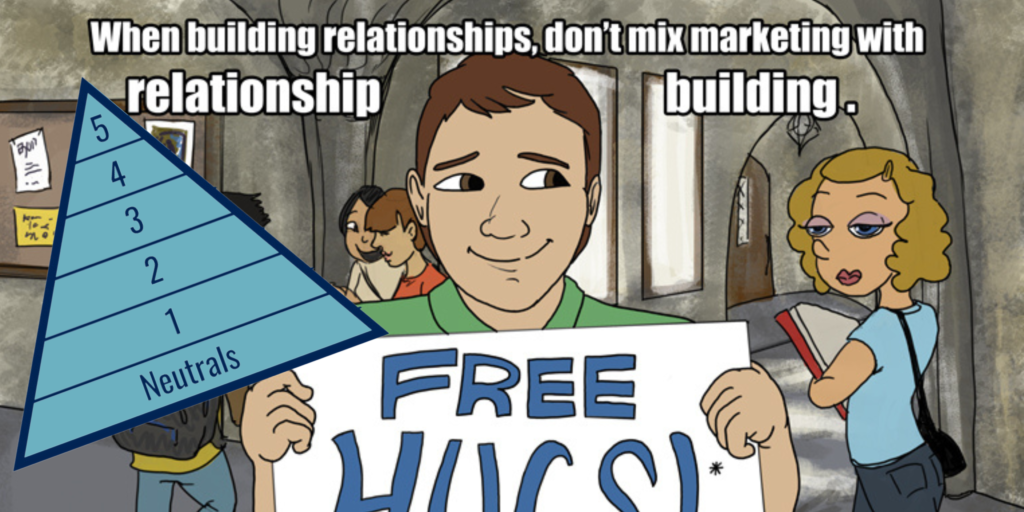As you walk down the street, you see me at the end of the block, holding up a “Free Hugs” sign. What do you do? If you’re a hugger, you might dive in for a squeeze. If you aren’t a hugger, you might smile as you pass by or cross the street faster than someone avoiding a political canvasser.
Now imagine that same scene, but this time, at the bottom of the “Free Hugs” sign, it says, “brought to you by Nike.”
Will it change our interaction?
Of course, it will. Instead of hugging me, you’ll assume I’m promoting something for Nike and that you’ll be pitched on something related to Nike if you engage.
In this post, I’ll explain why mixing marketing with relationship building is about as effective as trying to mix oil and water or my attempts at cooking—it just ends up a mess. More importantly, I’ll explain how genuine relationship-building is the ultimate marketing strategy. Stick to the end for a magic phrase that will be your cue to shift gears from gaining attention to building those connections.
Engagement Pyramid
In our leadership program, Dance Floor Theory, we use the Engagement Pyramid to understand the different levels of engagement within any team or organization. At the top are your ‘5s,’ the most engaged individuals, followed by the ‘4s,’ ‘3s,’ ‘2s,’ and at the bottom, your ‘Neutrals’ and ‘1s,’ who are the least engaged. Understanding where your audience falls on this pyramid can help you tailor your engagement strategies to their specific needs and preferences.

Gallup research shows that most of your people are at the bottom as Neutrals and 1s. Gallup calls those people Disengaged people, and their studies show that this group makes up about 65% of your group. That’s a lot of people!
In Dance Floor Theory, we emphasize the importance of understanding and engaging with each level of the Engagement Pyramid. The idea that one style of engagement works for everyone is outdated. Each level thinks differently and wants to be interacted with differently. You can effectively engage your entire team or organization by adapting your approach to each level.
However, for this post, we are focusing on neutrals and 1s. To engage this group, you should focus on two things: getting their attention and then building a connection.
- Don’t ask them to join something. It’s too much.
- Don’t ask them to come to an event. It’s too much.
- Don’t ask them to help out. It’s too much.
Those types of engagement tactics don’t work for this group. Just focus on getting their attention and then building the connection.

This is where the idea of Blender Events comes in. I did a whole post on Blender Events, so I’m not going to go into detail here, but in short, they are activities specifically designed to gain attention and build connections.
The Free Hugs campaign is a well-known example of a Blender Event. It started as a simple act of offering free hugs to strangers to spread love and positivity. The campaign gained attention and built connections with people from all walks of life, demonstrating the power of genuine, non-commercial interactions.
When someone holds up the sign as people walk by, the people usually look at it (attention) and sometimes hug them (connection).
But warning, warning, warning.
Far too often, I see people slapping their logos on these signs. So it reads, “Free Hugs brought to you by Nike” or “Student Government.”
When you do that, just know that you are no longer building relationships; you are now just marketing. They will probably still look (attention), but they most likely won’t stop and give you a hug, so you’ll miss out on the connection.
When people sense an underlying marketing motive in an offer meant to build a relationship, it changes everything. It’s like inviting someone out for coffee and then pulling out a multi-level marketing pamphlet as they sip their latte. Suddenly, the coffee tastes less sweet, and the connection feels less genuine.
In Dance Floor Theory, we say that you should never mix marketing with relationship building.
Good Relationship Building Is Good Marketing
But here’s a twist for you. If relationship building is done right, it transforms into the most potent form of marketing. It’s like slipping veggies into a kid’s meal – they don’t realize it’s good for them, but they devour it anyway. When you focus on genuinely connecting with people without the shadow of a sale looming over you, you create a bond that’s stronger than any billboard or email blast. People share their positive experiences, and that’s the gold standard of marketing.
Remember, nobody ever shares a cold call story at dinner parties. But a story about an unexpected, genuine connection? Pass the wine because everyone wants to hear that one.
Magic Phrase: What’s going on?
During your process of running a Blender Event, you are going to hear a magic phrase. To set this up, let me share a quick backstory.
Story Time
At some point, every facilitator eventually runs out of activities they can do with a group. It’s natural and bound to happen. It’s happened to me many times in longer programs. This exact thing happened to a friend of mine, Kevin Prentiss, who was running a 10-day long summer program for a group of students at Stanford University. After ten days of facilitating activities and content, his bag of tricks was empty. He found himself on the tenth day with an extra hour that he needed to fill for the 150 students in a large grassy courtyard on campus. In a flash of genius, he circled up four students nearby and asked them if they’d be interested in playing a game. They eagerly nodded in agreement. They didn’t know Kevin’s plan was more of a social experiment than a game.
In their huddle, Kevin explained that the game’s name was “Scream and Run!” The students laughed as he explained, “Your challenge is to run as fast as possible towards the rest of the group while screaming. Then run back doing the same.” The group laughed again. “Oh, but one thing, we won’t tell anyone what we are doing unless they come over here and ask us. Ok?”
The group nodded and lined up to start the experiment. Kevin yelled, “Go!” and off they went. The four students turned towards 146 unsuspecting peers, started running, and yelled with their mouths wide open the whole time. When they returned to the corner of the grassy field with Kevin, they laughed hysterically and high-fived each other.
The experiment proved successful because five other students approached the corner and asked, “What’s going on? What’s going on?”
Kevin explained the game to them, and they joined in for round two. The group lined up, and Kevin yelled, “Go!” again. The group of nine charged forward on the grassy field with mouths wide open.
After they returned and gave each other high-fives, another group of 10 students came over to the corner and asked, “What’s going on? What’s going on?”
Again, Kevin explained, and they joined. This went on for six rounds before 150 students were waiting in the corner for Kevin to yell “Go!” so they could scream and run. All Kevin was thinking at that moment was how stupid the game was but how successful his experiment had been.
This story matters to what we are discussing in this post because it shows us that a magic phrase repeatedly occurs during Blender Events when trying to engage the least engaged people in our community.
Did you notice that after every round of the scream and run game, someone came over and asked the group, “What’s going on?” but they didn’t say it normally. They said it like they didn’t care. Kevin had unwittingly stumbled upon the golden nugget of engagement. The nonchalant saying, “What’s going on?” wasn’t just curiosity but the bridge from disinterest to engagement. The beauty of this magic phrase lies in its simplicity. It’s not a commitment, it’s not an RSVP – it’s an open door. When you hear this phrase, it’s your cue. Roll out the red carpet of engagement, but keep it casual. Remember, if you come on too strong, you’ll scare them back into the realm of the 1s and Neutrals. It’s like trying to pet a stray cat; move slowly, or you’ll just end up talking to yourself. When you hear this phrase while running a Blender Event, you should internally celebrate because it means you’ve successfully gotten their attention. Now, they have permitted you to build the connection.
And there it is!
So, what have we learned today? Other than that, I can’t pull off a Nike sponsorship. Mixing marketing with genuine relationship efforts is about as seamless as wearing socks with sandals – sure, you can do it, but should you? Instead, focus on genuinely connecting with your community. Build those relationships without an agenda, and watch as the marketing magic naturally unfolds. And when you’re out there, running your version of the “Scream and Run,” listen for the magic phrase, “What’s going on?” That’s your cue. You’ve got their attention; now make the connection.
Remember, at the end of the day, it’s not about the number of impressions a logo makes; it’s about the people and the connections you make. So, the next time you’re tempted to slap a logo on your free hugs sign, maybe just hold up a hand instead and see who reaches out. After all, in the grand scheme of things, a genuine connection is worth more than all the Nike sponsorships worldwide. Well, unless Nike actually wants to sponsor me, in which case, I’m all ears.
Until next time, keep blending, not branding. And who knows? Maybe one day, your community will be so engaged you’ll find yourself running around screaming, wondering, “What’s going on?”
